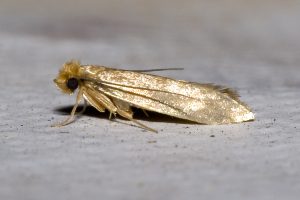 INTRODUCTION: This species is the most commonly encountered clothes moth in the United States. Its common name comes from the larval produced silk webbing which characteristically covers over the area upon which the larva is feeding. This pest is found throughout the United States and the world.
INTRODUCTION: This species is the most commonly encountered clothes moth in the United States. Its common name comes from the larval produced silk webbing which characteristically covers over the area upon which the larva is feeding. This pest is found throughout the United States and the world.
RECOGNITION: Adults measure about 1/2” (12 mm) from wing tip to wing tip, both wings are long and narrow. Wings and body uniformly buff/golden color except for tuft of reddish setae (hairs) on top of the head. Mature larva up to 1/2“ (12 mm) long. Whitish and shiny except for brownish head. Ocelli absent.
DAMAGE AND SIGNS OF INFESTATION: There are silken tubes in the hidden portions of clothes, such as under collars, or silken mats or patches on material. Both the tubes and mats, have fibers and feces incorporated into them. Surface grazing of fibers and/or holes in material are present. In fur, the hairs are clipped at their base causing loose fur and exposed hide.
BIOLOGY: On the day they emerge from their cocoon, adults females can mate and lay eggs. Each female lays an average of 40—50 eggs (range 30—221), either singly or in small groups over a 2-3 week period, and glues them to material. The eggs hatch within 4-10 days in summer but may require up to 3 weeks in winter. Most larvae spin a silk tube or tunnel into which are incorporated fibers and feces or they merely spin a flat silken mat. They then feed within the confines of the tube or mat. Some larvae will crawl about unprotected.
The pupal stage lasts about 8-10 days in summer but may require up to 44 days in winter. Females die after all their eggs are laid, usually in about 16 days, whereas males live an average of about 28 days.
HABITS: For all practical purposes, webbing clothes moth larvae do not attack materials of vegetable origin. They attack synthetic fibers only when they are interwoven with natural animal fiber material or are soiled. They feed on keratin-containing materials such as wool, hair, fur, etc. They have been found infesting beef meal, fish meal, pemmican, casein, and milk products in addition to furs, woolens, etc. Outdoors, clothes moths have been found in the nests of birds and insects.
The larvae prefer to feed in hidden places such as under collars, on carpeting from the back/jute/underneath side, etc. However, under heavy infestation situations, larvae may crawl about exposed, such as under a heavily infested sofa. Larvae do much better in areas of high humidity.
The adults do not feed. They shun light, not being attracted to lights as are most moth species. Females are poor fliers but are fast on their legs and run when disturbed. Males may fly up to 100 yards but seldom do so. When disturbed, they quickly seek a secluded/hidden place such as in fabric folds, etc.
CONTROL: The key to control is proper identification, a thorough inspection, good sanitation, and pesticide application when required. Refer to this section under the general treatment of fabric and paper pests for details. If the source(s) of the infestation cannot be found in the usual places, check the air ducts and especially the cold air return. If this is a problem area, the ducts should be professionally cleaned. If pets are or have been present, check where pet hair may accumulate such as behind and under baseboards, between cracks of flooring, etc.
